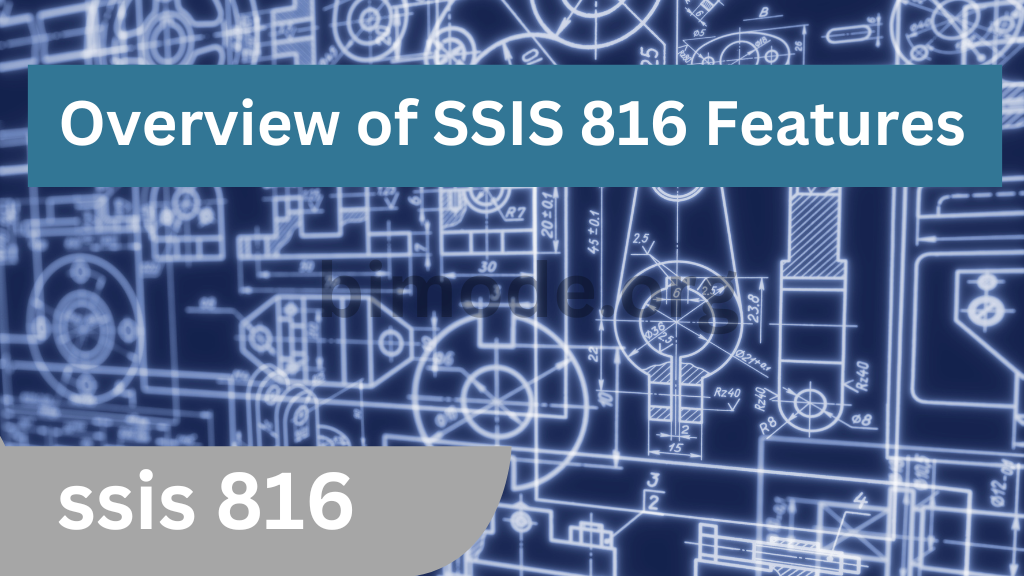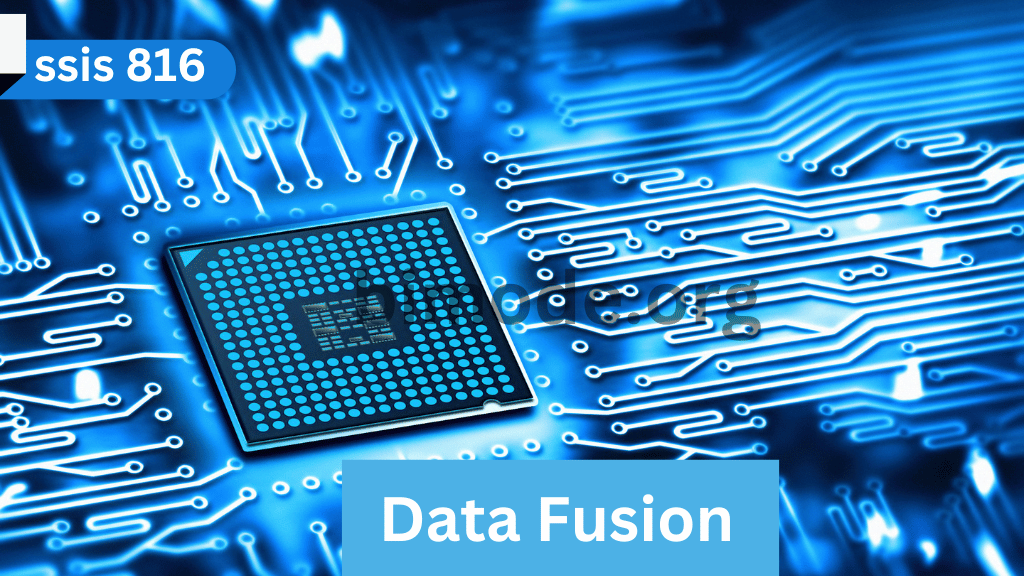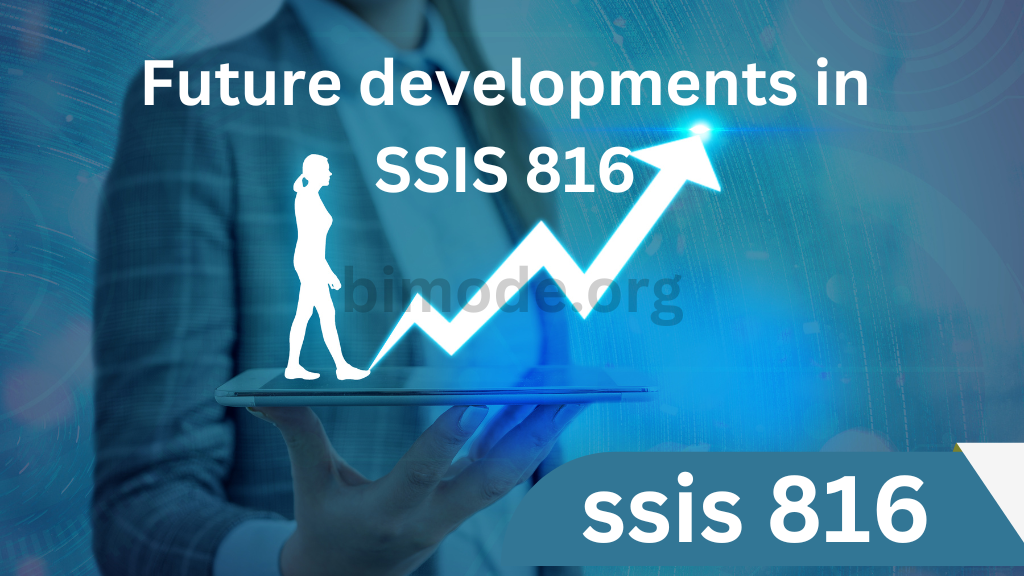Understanding SSIS 816
SSIS 816 is the pinnacle of data integration tool evolution, providing organizations with a comprehensive platform for data extraction, transformation, and loading (ETL). With its easy interface and powerful functionality, SSIS 816 enables users to effectively orchestrate complicated data operations, assuring efficiency and accuracy throughout the integration process.
As we investigate this key aspect of SQL Server Integration Services (SSIS), prepare to set aside the scary technical guides in favor of a short, accessible explanation. Whether you are a seasoned IT expert or an interested newcomer learning about data management, our investigation of the foundations of SSIS 816 will provide significant insights for everyone.
What is SSIS 816?
SSIS 816 stands for SQL Server Integration Services (SSIS), a component of Microsoft SQL Server version 8.16. It is a platform for developing enterprise-scale data integration and transformation solutions. SSIS can extract and transform data from a variety of sources, including XML files, flat files, and relational data sources, before loading it into the destination of your choosing.
SSIS 816 provides significant advancements in data integration capabilities. This strong platform is designed to deliver smooth data transformation and transfer thanks to its foundations in the Microsoft ecosystem.
Historical Background
With the introduction of SSIS 816, Microsoft improved their data integration toolset. The first tool offered was SQL Server Integration Services, which has been significantly improved with each following edition. The 816 edition is a significant milestone that provides unprecedented customization and efficiency.
Overview: Features of SSIS 816

In terms of data integration, SSIS 816 represents groundbreaking advancements. This robust platform, built on a strong Microsoft architecture, can assist companies of any size with their data transformation and transfer requirements.
SSIS 816 is distinguished by its outstanding efficiency and versatility. It is crucial for data transformation and extraction applications because to its vast feature set. SSIS 816 is the instrument for assisting with data transfer or the automation of complex tasks.
In addition, SSIS 816 builds on previous versions by introducing features that make it more scalable and quicker. Improving error handling and extending connectivity options are just two of the ways this latest edition takes data integration to new heights.
Furthermore, SSIS 816 features an easy-to-use interface that streamlines ETL development. Users with no coding skills may create complicated data pipelines using the straightforward drag-and-drop interface.
- Advanced Data Transformation: SSIS 816 improves data transformation capabilities, making it easier for users to do complicated data manipulations. Including additional transformation components and better data flow tasks results in more efficient data processing.
- Improved Performance: One of SSIS 816’s distinguishing features is its optimized performance. With changes to the data flow engine and memory management, SSIS 816 can handle bigger datasets and more complicated processes in less time.
- Improved Connectivity: SSIS 816 is compatible with a diverse set of data sources & destinations, such as relational databases, cloud-based services and NoSQL databases. The addition of additional connections and adapters allows for smooth integration with current data platforms.
- Scalability and Parallelism: SSIS 816 has better scalability and parallel processing capabilities, allowing users to expand their data integration solutions based on their requirements. The ability to run numerous data flows in parallel improves efficiency and throughput.
- Advanced Error Handling: Error handling is an important part of any ETL process. SSIS 816 has more advanced error-handling methods, allowing users to better manage and debug data processing difficulties. Customizable error channels and thorough recording provide for more control over data integrity.
Exploring Key Features of SSIS 816 for Data Fusion

SSIS 816 has a wide range of features designed to meet the various demands of modern businesses:
- Enhanced Data Extraction: SSIS 816 allows you to extract data from a multitude of sources, including flat files, databases, and online services, providing smooth integration and consistency.
- Advanced Data Transformation: With SSIS 816, users may execute complex data transformations such as cleaning, aggregating, and formatting to meet unique business needs.
- Efficient Data Loading: SSIS 816 provides a variety of loading mechanisms, including sequential, parallel, and bulk loading, to improve data integration performance and scalability.
- Workflow Automation: SSIS 816 allows you to automate complex integration workflows, simplifying repetitive tasks and assuring flawless execution.
- Robust Error Handling: SSIS 816 has robust error management features that let users to quickly discover and resolve errors, ensuring data integrity and dependability.
- Data Integration: Extract information from a variety of data sources. Transform and purify data in accordance with business principles. Load data into many destinations, including databases and data warehouses.
- Control Flow: Manage the workflow of tasks subject to priority restrictions. Execute a variety of tasks, including file system operations, data flow tasks, and scripting.
- Data Flow: From source to destination, Data movement Tasks manage the movement of data. Perform complicated data transformations such as sorting, combining, and aggregating.
- Built-In Connectors: A diverse set of built-in connections for many data sources, including SQL Server, Oracle, Excel, and others. Custom connections can also be created.
- Script Task and Components: Allows you to enhance the functionality using custom scripts in C# or VB.NET. Useful for sophisticated transformations and customized business logic.
- Error Handling and Logging: To manage data quality challenges, robust error handling is required. Built-in logging allows you to trace package execution and diagnose issues.
- Deployment and configuration: SSIS Catalog simplifies the deployment model. Configuration options to make packages environment-independent.
- Scalability and performance: Parallel execution of tasks and data flow components. Buffering and blocking transformations are among the strategies used to optimize performance.
Benefits of SSIS 816
- Productivity: An intuitive visual design interface accelerates the development process. Reusability of components and tasks increases productivity.
- Scalability: Can handle vast amounts of data effectively. Ideal for both small and big business contexts.
- Integration: With other Microsoft products like SQL Server, Azure, and Visual Studio, seamless integration is provided. Enables integration with third-party data sources and applications.
- Flexibility: A wide variety of built-in tasks and transformations. The ability to create bespoke scripts and tasks for complicated circumstances.
- Reliability: Robust error handling and recording ensure dependable data integration solutions. The built-in features assure data integrity and consistency.
- Cost-Effective: Part of the SQL Server suite, providing a complete solution without the need for other tools. Reduces the need for specialized coding and laborious data management.
SSIS 816 is a powerful ETL tool that offers a comprehensive solution for data integration and transformation, making it an essential tool for enterprises dealing with large volumes of data from several sources.
Main Perks of Using SSIS 816
There are a number of significant benefits to using SSIS 816 that make it a vital tool for companies. One of its numerous advantages is the ease and versatility with which it tackles data transformation tasks. Companies may now quickly transport data between systems, extract, modify, and process it.
Another advantage of SSIS 816 is that it is built on a stable foundation that is part of the Microsoft ecosystem. Because of this, customers can be confident that their purchase will work in tandem with all of their other Microsoft products and services. The ETL operation is further eased by SSIS 816’s extensive features and capabilities, which represent a quantum leap ahead in data integration technology.
Furthermore, because to its straightforward interface, even non-technical users can browse and use SSIS 816, which streamlines even the most complex data transformation procedures. If your company is serious about enhancing its data manage operations, SSIS 816 provides several advantages.
Adopting SSIS 816 has Various Advantages for Organizations
- Enhanced Efficiency: SSIS 816 streamlines data integration procedures and eliminates manual involvement, leading to enhanced productivity and ease of use.
- Improved Data Quality: SSIS 816 ensures data consistency and accuracy by executing extensive data transformations and cleaning, which leads to superior data quality and decision-making. SSIS 816 enhances resource usage and reduces downtime, leading to considerable cost savings and increased operational efficiency.
- Scalability: SSIS 816 is designed to handle large-scale data integration tasks, making it an excellent alternative for businesses with expanding data requirements.
- Real-Time Integration: SSIS 816 offers real-time data integration, allowing organizations to process and analyze data in near real time to gain actionable insights.
- Efficiency and Speed: SSIS 816’s powerful data transformation and enhanced performance features considerably minimize the time necessary for data integration tasks. This efficiency results in speedier decision-making and higher operational productivity.
- Flexibility and Versatility: SSIS 816’s many connection options and support for several data formats make it an adaptable solution for a wide range of data integration applications. SSIS 816 is capable of dealing with both structured and unstructured data.
- Scalable Solutions: As organizations develop, their data integration requirements get more complicated. The scalability of SSIS 816 assures that data operations may expand to meet increased demand without sacrificing performance.
- Improved Data Quality: The enhanced error handling and transformation features in SSIS 816 help to improve data quality. SSIS 816 helps to protect sensitive company data by effectively controlling mistakes and guaranteeing reliable data processing.
Applications for SSIS 816
- Data Warehousing: SSIS 816 is commonly used in data warehousing projects to extract data from several sources, convert it to a proper format, and put it into data warehouses.
- This process provides complete data analysis and reporting support.
- Business Intelligence: SSIS 816 facilitates the integration of data from several sources, resulting in a single picture of company data. Advanced analytics and informed decision making are supported by this integration.
- Cloud Data Integration: SSIS 816’s improved connectivity capabilities make it ideal for integrating on-premises data with cloud-based platforms. For organizations implementing hybrid or cloud-first strategies, this capacity is crucial.
- Data Migration: SSIS 816 is an excellent solution for data migration projects because it allows data to be transferred seamlessly across multiple systems and platforms. Its powerful transformation capabilities assure data consistency and accuracy throughout migrations.
Drawbacks of SSIS 816 for Large Data Management
Although SSIS 816 provides many beneficial features and benefits, it also has several drawbacks that you should be aware of. One of the most significant challenges that users may face is the high learning curve required to become adept with this sophisticated platform. Its advanced features may make it tough for newbies to grasp at first.
Another disadvantage is that dealing with enormous volumes of data may result in performance issues. Despite its efficiency, SSIS 816 occasionally faces slowdowns or bottlenecks when dealing with large workloads. To keep processes functioning smoothly, optimization techniques are required.
Furthermore, organizations or small businesses with limited resources may be concerned about licensing costs. Their budget constraints may prohibit them from making the necessary investments to implement and maintain SSIS 816.
Also, while SSIS 816 may lack some complex features as compared to other ETL tools, it performs admirably in terms of data transformation and transfer inside the Microsoft environment. Those who want highly specialized features may need to consider other options that better meet their requirements.
Common Problems and Solutions for Data Managment & Integration
Despite SSIS 816 is dependable, users may encounter typical issues such as package execution errors, connectivity issues, performance bottlenecks, and security threats. Here are some solutions that will properly handle these issues:
- Package Execution issues: Use strong error handling techniques to quickly manage and troubleshoot issues.
- Connectivity difficulties: To avoid connectivity difficulties, ensure that data sources and destinations are properly configured.
- Performance bottlenecks: Improve SSIS 816 performance with parallel processing, effective data transformation algorithms, and caching.
- Security Concerns: Use strong security features and compliance controls to protect sensitive data and maintain regulatory compliance.
Best Alternatives to SSIS 816
Isn’t SSIS 816 what you were searching for? There are a number of ETL solutions available if you need assistance with data integration. The scalable and feature-rich Informatica PowerCenter is a popular option. Talend Open Studio, with its simple UI and broad connection API, is another serious competitor for quick data integration.
The visual flow-based programming methodology of Apache NiFi makes it a strong contender among open-source alternatives. IBM InfoSphere DataStage’s extensive data transformation capabilities and enterprise-level scalability make it a strong candidate. AWS Glue and Google Cloud Dataflow are two reliable cloud-based alternatives with comprehensive ETL features.
Consider your company’s specific needs, budget, scalability constraints, and chosen level of user-friendliness when determining which option to SSIS 816 is the best match. Each instrument has benefits and drawbacks; choose the one that will assist your company reach its objectives.
Best Practices to Maximize Data Integration Via SSIS 816
To maximize SSIS 816 installations, consider the following recommended practices:
- To ensure scalability and efficiency, carefully plan and develop data integration operations.
- Effective Error Handling: Use robust error handling techniques to properly manage and troubleshoot issues.
- Performance Optimization: Improve SSIS 816 performance by using parallel processing, effective data transformation algorithms, and caching.
- Maintain extensive documentation of SSIS packages and configurations for simpler troubleshooting and maintenance.
How to Select the Right ETL Tool for Your Business
Selecting an ETL solution for your company requires you to consider a number of things:
- Determine the expectations and requirements of your specific data integration project. Get a sense of the data sources, the volume of data you’ll be processing, and the complexity of the transformations you’ll need.
- The ETL tool’s scalability and versatility should be evaluated next. Make sure it can handle your company’s growth and the evolution of your data processing requirements.
- Think about the tool’s learning curve and ease of use. An intuitive interface and excellent support resources can have a significant impact on deployment success.
- Things to consider when selecting a solution include the price, compatibility with your present systems, the offered security features, and the vendor’s reputation.
- After careful examination of these factors, you may select an ETL solution that aligns with your company’s objectives and ensures successful data integration operations.
Resources for Further Learning About Data Integration

For people wishing to expand their understanding on SSIS 816, there are numerous resources available:
- Microsoft Documentation: You can get full SSIS 816 documentation on the Microsoft website.
- Online Training & classes: To grasp SSIS 816, enroll in training classes on platforms such as Pluralsight, Coursera, and Udemy.
- Blogs & Community Forums: Engage in conversations and read blogs about SSIS 816 for practical insights and tips.
- Textbooks and Electronic Resources: Investigate books and eBooks on SSIS ideas for a thorough knowledge.
Conclusion
Having the right resources is crucial in the fast-paced world of data integration and transformation. When it comes to effective data processing for a wide range of applications, SSIS 816 is a powerful platform. It is a game changer in the field of ETL tools, because to its extraordinary efficiency and versatility.
Before deciding on a replacement for SSIS 816, business owners should carefully consider their specific requirements and objectives. Whether you’re seeking for open-source solutions or other commercial goods, there are a number of options worth considering, each with its unique set of features.
Scalability, user-friendliness, support for many data sources, and cost-effectiveness are some of the factors to consider when selecting an ETL tool for your company. You may make an informed decision that will accelerate good data management initiatives by carefully evaluating these factors and understanding your organization’s requirements.
Frequently Asked Questions (FAQ) about SSIS 816
What is SSIS 816?
SSIS’816 is the most recent version of SQL Server Integration Services, a sophisticated data integration and transformation tool created by Microsoft.
What are the primary features of SSIS 816?
SSIS 816 includes improved performance capabilities, increased security features, simpler integration with Azure services, and improved data quality and governance tools.
How does SSIS 816 enhance data management?
SSIS’816 provides improved data processing algorithms, strong encryption methods, easy integration with Azure services, and complete data quality and governance tools to help organizations manage their data assets more effectively and securely.
Is SSIS 816 suitable for all sizes of businesses?
Yes, SSIS’816 meets the demands of businesses of all sizes, from tiny start-ups to major corporations. Its scalability, versatility, and ease of use make it an adaptable option for a variety of data management needs.
Where can I learn more about the SSIS 816?
For more information about SSIS’816 and how it may help you improve your data management skills, please see Microsoft’s official documentation or speak with a qualified Microsoft partner. You may also learn from professionals and other users by visiting SSIS’816-specific online resources and forums.
What are the system requirements for installing SSIS 816?
The system requirements for SSIS 816 might vary based on the environment and deployment situation. For more complete information, please refer to the official documentation.
Can SSIS 816 work with third-party tools and platforms?
Yes, SSIS 816 allows integration with a broad number of third-party tools and platforms, allowing for smooth interoperability and data interchange.
Is SSIS 816 suitable for small or large businesses?
SSIS 816 is scalable and flexible to businesses of all sizes, making it suitable for both small and large firms.
How does SSIS 816 keep data secure and compliant?
SSIS 816 has several security measures and compliance controls to safeguard sensitive data and ensure regulatory compliance.
Can the SSIS 816 handle real-time data processing?
Yes, SSIS 816 offers real-time data processing, allowing organizations to process and analyze data in near real-time for actionable insights.
What support options are available for SSIS 816 users?
Microsoft provides substantial support for SSIS 816 users, including documentation, forums, and specialized support channels for assistance with debugging and technical concerns.




